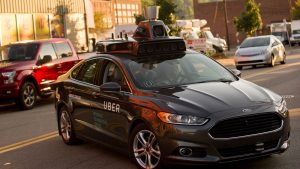One of Uber’s earliest investors says the billions it spent on self-driving were a ‘waste of money’

- Early Uber investor Bill Gurley said the company “burned” billions of dollars on self-driving tech.
- That money would have been better spend on food delivery, he toldjournalist Eric Newcomer.
- Uber’s sold off its self-driving unit in late 2020 as it grappled with a revenue downturn.
- Visit Business Insider’s homepage for more stories.
Uber’s food-delivery business has been a massive boon for the company as the pandemic sent ride-hailing revenues down the tubes and takeout orders through the roof.
One early investor in the company, Benchmark’s Bill Gurley, says the company should have committed more investment to food delivery that it instead spent trying to build self-driving vehicles.
In an interview with journalist Eric Newcomer in his newsletter Friday, Gurley lamented that Uber dumped so much capital into its self-driving unit, called the Advanced Technologies Group (ATG). Gurley’s firm, Benchmark Capital, first invested in Uber in 2011, according to Pitchbook data. Gurley sat on Uber’s board until 2017.
“We probably burned $2.5 billion on autonomous that was a waste of money,” Gurley said, adding that in retrospect that sum would have been better spent on growing Uber Eats.
However, he said, there still would have been major risks to investing heavily in delivery.
“These ideas where you use capital as a weapon to build liquidity and then emerge out of it later is a really hard and dangerous game, and you need the capital markets to support it,” Gurley said. “And if we hadn’t gone from a frothy market five years ago to a super frothy market now, maybe you don’t make that gap.”
Uber has historically struggled to turn a profit — it reported an adjusted net loss of $8.5 billion in 2019, for example — leading it to double down on core businesses and trim some capital-intensive side projects as the pandemic slashed revenues. In December, the company announced plans to sell its ATG unit to the competing autonomous-vehicle firm Aurora, and its flying taxi program to Joby Aviation.
The appeal of self-driving vehicles for a ride-hailing service is clear: if Uber could develop robotaxis capable of reliably ferrying passengers around without intervention, it would theoretically save heaps on payroll and other costs associated with employing human drivers. But that’s much easier said than done.
Since its founding in 2015, Uber ATG struggled to make significant headway toward building an autonomous taxi, falling behind competitors like Alphabet’s Waymo and GM’s Cruise. The firm was plagued by infighting, allegations that its lead engineer stole trade secrets from Google (he was later convicted and pardoned by President Donald Trump), and a fatal crash in 2018 that’s considered to be the first deadly incident involving a self-driving car.
Axel Springer, Insider Inc.’s parent company, is an investor in Uber.